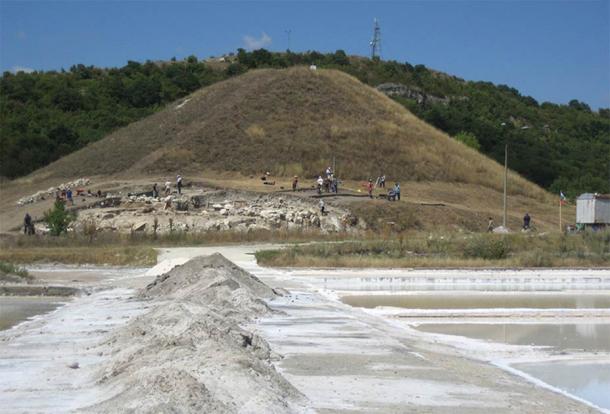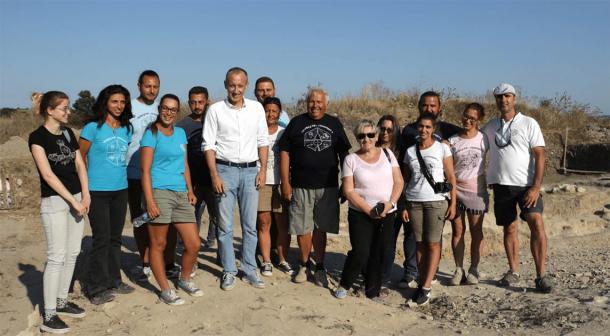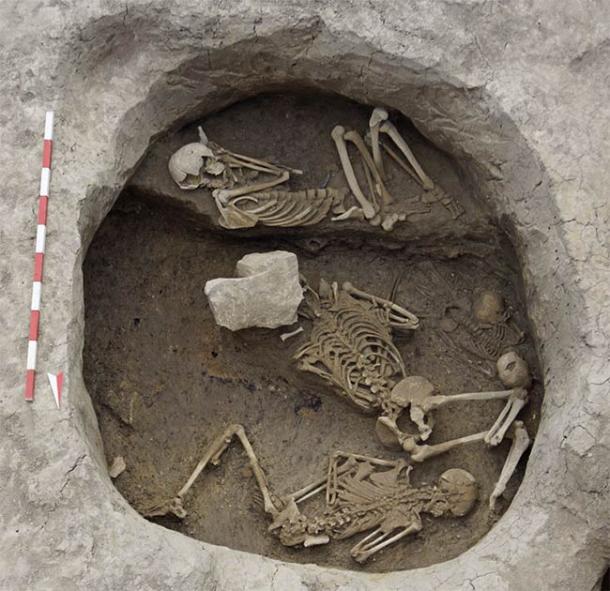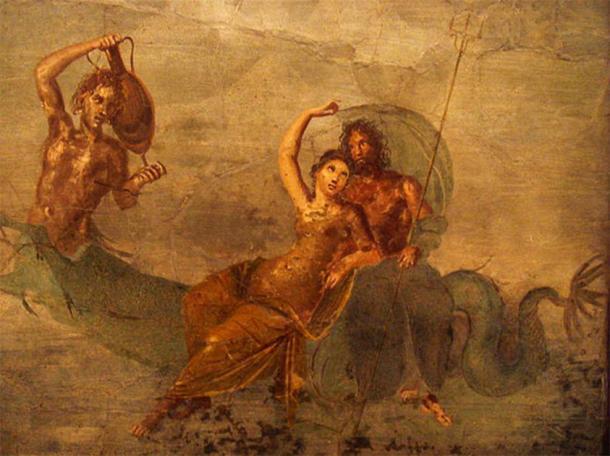In the ancient world salt was so valuable that Roman soldiers were sometimes paid with salt instead of money . A monthly salt allowance was a salarium, and this Latin word seeds both the French word salaire, and the English language word salary. When salt first appeared on the market it circulated in its economic capacity for a long time before it was consumed, and this is why the ancient salt mines at Provadia-Solnitsata are regarded as the first mint in ancient Europe, and the home of long-distance trade. Thanks to a new discovery, it is also the site of a salt god artifact.

The Provadia-Saltworks tell during excavations in 2008. A new discovery has uncovered what appears to be a representation of some kind of salt god. (Nikolov / OpenEdition Journals )
Salt Cults of the Ancient World
Located near the modern town of Provadia, in northeastern Bulgaria, specialized salt production and long-distance trade was vital for both people and animals at the prehistoric urban Chalcolithic complex of Provadia-Solnitsata during the middle and second half of the 5th millennium BC. This fortified stonewall settlement (citadel) includes a ritualistic sacrificial pit and an extensive burial necropolis, representing the oldest salt production center in Europe, dating back to between 5500 and 4200 BC.
According to the Bulgarian Academy of Sciences Institute of Archaeology , over the last 30 years the early Neolithic and late Neolithic history of the Balkans and Anatolia has been championed by the intrepid Prof. Vasil Nikolov. This summer, along with a team of researchers, Nikolov explored the bottom of a salt evaporation pool as well as two houses, one of which was a 400 square meter (4305 ft2), two-storey building. While at it, he unearthed six human skulls, including children.

Prof. Vasil Nikolov and his team working at the Provadia-Saltworks where the salt god artifact was discovered. ( Provadia-Solnitsata)
Because Aliens Don’t Have Mouths
The finds at the Provadia-Saltworks included a unique late Chalcolithic triangular-shaped ceramic artifact depicting an anthropomorphic human face. Believed to be a salt god, the artifact has two stylized ears and eyes, but no mouth. Its eyes are elliptical while its eyebrows were painted on. The Bulgarian artifact has two holes which most likely served for hanging. Researchers at the site think this object was a symbol of high status within the social hierarchy.
You will have noticed that whenever any kind of triangular human face is recovered from an ancient site there’s always someone who can’t resist using the old school bait and switch “alien reference.” In this case it’s ArchaeologyNewsNetwork who headlined this story with “Mouthless ‘Alien Mask’ Found.” But, just so you know, not a single archaeologist concerned with this discovery has mentioned that the ancient ritualistic object looks like an “ alien,” and this remains the play of a handful of sensationalist journalists trying to grab a few ancient alienists as they pass by looking for the smoking guns they so much love to find.

At the Provadia-Solnitsata site archaeologists have discovered several human remains, including a mass grave was found holding the smashed remains of victims that had suffered violent deaths. (Nikolov / OpenEdition Journals )
A Salt Cone at the Center of Long-distance Trade
Provadia-Solnitsata is the most ancient salt production center of the Old World and it occupies an area of approximately 13 hectares (32 acres) of the famous Mirovsko salt deposit. According to a 2016 paper published in Open Journals , this site is one of “the most significant prehistoric sites in Southeastern Europe.” At a depth of 4,000 meters (13,123 ft.), with a 15 kilometer (9.3 mile) diameter, this giant salt cone occurred when huge amounts of salt were pushed upwards to the surface under extreme pressure, and its marl, or mantle, protected it from dissolution.
It was at this site ancient that people first “brine boiled” pottery in dome ovens between 5500and 5200 BC. During the Middle and Late Chalcolithic (4700‑4200 BC) salt production at this site reached almost industrial levels, and it was traded with cultures as far away as the southern Balkan Mountains.

Could the salt god artifact discovered be a depiction of Salacia, identified with the Greek goddess Amphitrite, seen here in an ancient Roman fresco. ( Stefano Bolognini )
Salt Gods or Aliens Visitors. You Decide
Although this was an industrial complex, it was also a ritual center, a fact that became clear after the discovery of thirty pits about 60 meters (196 ft) west of the main mound (tell). Covering an area of around 0.2 hectares (0.49 acres) researchers have found evidence that these pits were associated with a fertility cult dedicating their worship to a salt god or an agri-mother goddess. A second ritual pit complex was found in a vast prehistoric necropolis containing graves and stone structures about 250 meters (820 ft.) southwest of the main settlement, closer to the salt production center, and this further confirmed the deeply-sacred nature of the ancient complex.
Along with 38 single person graves, a mass grave was found holding the smashed remains of victims that had suffered violent deaths at the Bulgarian site. It is thought that a drought had caused the disappearance of the salt springs at the end of the 5th millennium BC, sparking inter-community conflict at the ancient salt production center of Provadia-Solnitsat.
So I leave it to you to decide if the triangular head represents an alien, or an early prehistoric conception of the Roman goddess Salacia , the female divinity of the sea, worshipped as the goddess of salt water. I’ll be going with the latter. Just sayin’.
Top image: Prof. Vasil Nikolov and his team of archaeologists at the Provadia-Saltworks found the ceramic artifact, believed to be a salt god, while excavating the bottom of a salt evaporation pool. Source: Provadia-Solnitsata
By Ashley Cowie
 RSS Feed
RSS Feed















 November 26th, 2020
November 26th, 2020  Awake Goy
Awake Goy  Posted in
Posted in  Tags:
Tags: 













